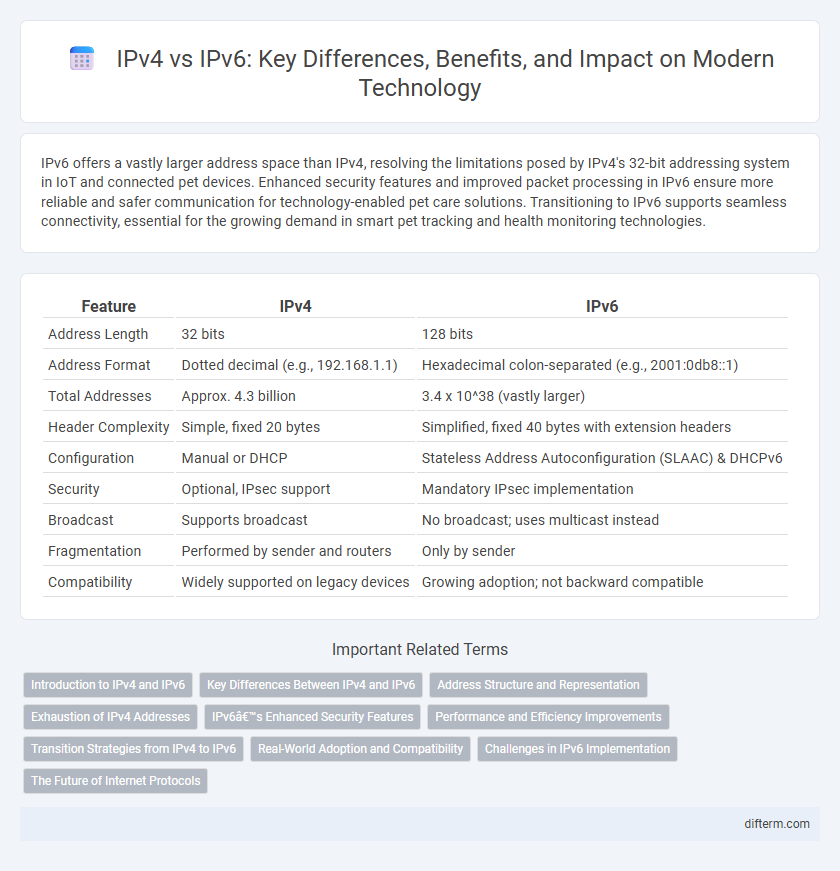IPv6 offers a vastly larger address space than IPv4, resolving the limitations posed by IPv4's 32-bit addressing system in IoT and connected pet devices. Enhanced security features and improved packet processing in IPv6 ensure more reliable and safer communication for technology-enabled pet care solutions. Transitioning to IPv6 supports seamless connectivity, essential for the growing demand in smart pet tracking and health monitoring technologies.
Table of Comparison
| Feature | IPv4 | IPv6 |
|---|---|---|
| Address Length | 32 bits | 128 bits |
| Address Format | Dotted decimal (e.g., 192.168.1.1) | Hexadecimal colon-separated (e.g., 2001:0db8::1) |
| Total Addresses | Approx. 4.3 billion | 3.4 x 10^38 (vastly larger) |
| Header Complexity | Simple, fixed 20 bytes | Simplified, fixed 40 bytes with extension headers |
| Configuration | Manual or DHCP | Stateless Address Autoconfiguration (SLAAC) & DHCPv6 |
| Security | Optional, IPsec support | Mandatory IPsec implementation |
| Broadcast | Supports broadcast | No broadcast; uses multicast instead |
| Fragmentation | Performed by sender and routers | Only by sender |
| Compatibility | Widely supported on legacy devices | Growing adoption; not backward compatible |
Introduction to IPv4 and IPv6
IPv4, established in the early 1980s, uses 32-bit addresses allowing approximately 4.3 billion unique IP addresses, which are rapidly depleting due to internet growth. IPv6, developed by the Internet Engineering Task Force (IETF), employs 128-bit addresses, enabling 3.4 x 10^38 unique IP addresses to accommodate expanding network demands. IPv6 introduces enhanced features such as simplified header format, improved security with IPsec, and better support for mobile devices compared to IPv4.
Key Differences Between IPv4 and IPv6
IPv4 uses a 32-bit address scheme allowing for approximately 4.3 billion unique addresses, whereas IPv6 employs a 128-bit address scheme enabling 3.4 x 10^38 addresses, vastly expanding the number of devices that can be connected. IPv6 introduces simplified header formats and improved security features such as mandatory IPsec support, which are optional in IPv4. Enhanced auto-configuration and better multicast routing in IPv6 optimize network performance and scalability compared to the more limited capabilities of IPv4.
Address Structure and Representation
IPv4 addresses consist of 32 bits divided into four octets, represented in decimal format separated by periods (e.g., 192.168.0.1). IPv6 addresses expand to 128 bits, structured into eight groups of four hexadecimal digits, separated by colons (e.g., 2001:0db8:85a3:0000:0000:8a2e:0370:7334). This expanded address length in IPv6 enhances address space significantly while enabling more efficient routing and hierarchical addressing.
Exhaustion of IPv4 Addresses
IPv4 addresses have a finite pool of approximately 4.3 billion unique addresses, which have been nearly exhausted due to the rapid expansion of internet-connected devices. IPv6, utilizing a 128-bit address space, offers an exponentially larger pool of around 3.4 x 10^38 addresses, effectively resolving the limitations of IPv4 exhaustion. This vast address space of IPv6 supports the continued growth of the Internet of Things (IoT) and future-proofing global IP networking.
IPv6’s Enhanced Security Features
IPv6 incorporates advanced security features such as mandatory IPsec support, which ensures end-to-end encryption and authentication for data packets, enhancing network confidentiality and integrity. Unlike IPv4, where IPsec is optional, IPv6's built-in security protocols provide better protection against threats like data interception and spoofing. This intrinsic security framework positions IPv6 as a more robust solution for modern, secure communication networks.
Performance and Efficiency Improvements
IPv6 offers significant performance and efficiency improvements over IPv4 by supporting a vastly larger address space, which reduces the need for network address translation (NAT) and streamlines routing processes. Its simplified packet header enhances processing speed and lowers latency, enabling faster data transmission. Enhanced multicast and anycast capabilities in IPv6 further optimize network traffic management, boosting overall network efficiency.
Transition Strategies from IPv4 to IPv6
Transition strategies from IPv4 to IPv6 involve techniques such as dual-stack implementation, which allows devices to run both protocols simultaneously, ensuring compatibility and gradual migration. Tunneling methods like 6to4 and Teredo encapsulate IPv6 packets within IPv4 networks to facilitate communication during the transition period. Network Address Translation-Protocol Translation (NAT-PT) is also used to translate IPv6 traffic into IPv4, enabling interoperability between the two protocols.
Real-World Adoption and Compatibility
IPv4 remains widely deployed due to its long-established infrastructure, supporting approximately 4.3 billion unique addresses, but struggles with address exhaustion in modern networks. IPv6 adoption grows steadily, offering an effectively unlimited address space with 128-bit addressing and enhanced features like simplified header format and improved security protocols. Real-world compatibility challenges arise as legacy systems and devices often require transition mechanisms such as dual-stack deployment or tunneling to ensure seamless communication between IPv4 and IPv6 networks.
Challenges in IPv6 Implementation
IPv6 implementation faces significant challenges including the complexity of transitioning from IPv4, compatibility issues with legacy systems, and the need for extensive infrastructure upgrades. Network administrators must address address allocation, DNS configuration, and security policies specific to IPv6, which differ significantly from IPv4 protocols. Limited IPv6 adoption slows the return on investment, complicating the incentive for organizations to fully migrate their networks.
The Future of Internet Protocols
IPv6 offers a vastly expanded address space with 3.4 x 10^38 unique addresses compared to IPv4's 4.3 billion, addressing the exhaustion problem inherent in IPv4. Enhanced security features and improved routing efficiency make IPv6 essential for supporting the growing number of connected devices in the Internet of Things (IoT). As global adoption increases, IPv6 is positioned to become the dominant Internet Protocol, driving future innovations in networking and digital communication.
IPv4 vs IPv6 Infographic

 difterm.com
difterm.com